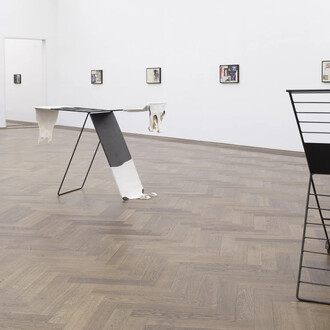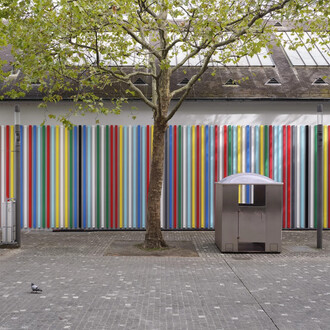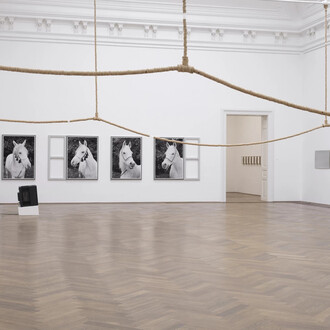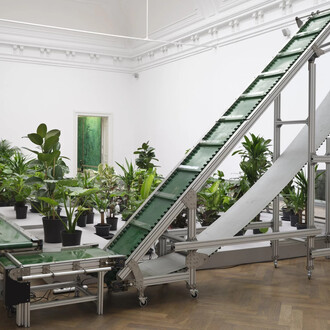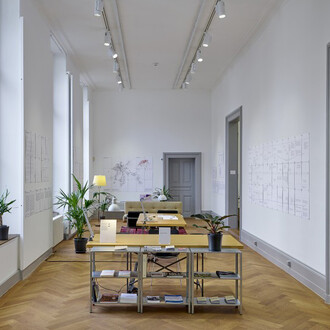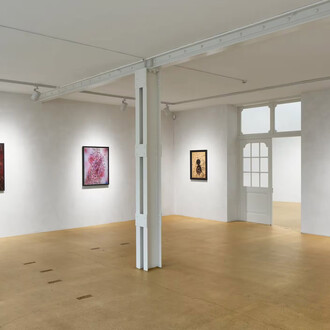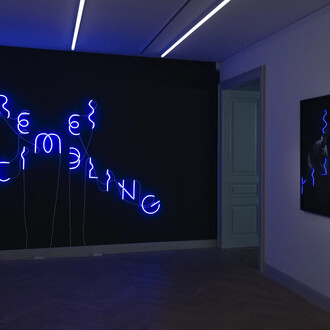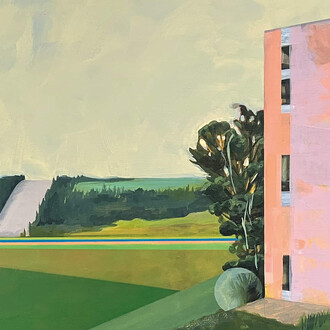Thirty black square vitrines extend across the back wall of Kunsthalle Basel like a linear archipelago, resembling islands plotted across a global map. They connect and divide, reveal and conceal. Between order and expansion, tradition and exploration, a field of tension unfolds, subtly alluded to in the title. Canons and Continents presents a site-specific installation by conceptual artist Marie Matusz, designed specially for this project. The “canons” in the title are reflected in the strict geometry and serial arrangement of the vitrines, calling to mind art historical legacies and the rules that govern art and society. Meanwhile, the “continents” open up broader perspectives, representing the vast diversity of cultural and social experiences.
In her titles, Matusz often embraces semantic ambiguities, resisting simple categorization and allowing a linguistic fluidity to infuse into the content of her works. This ambiguity con- trasts starkly with the industrial precision of the materials she uses. Unlike conventional museum vitrines that spotlight objects, Matusz presents black squares that jut out from the wall, hovering in space and obscuring what is inside. When passing by, these wallmounted sculptures seem to capture time, reflecting the surrounding environment and creating a tension between stillness and motion. They reveal more about the external world they mirror than their own internal structure. Rather than offering up immediate transparency, Matusz leans into translucency: only after confronting and overcoming one’s own reflection do hidden round steel segments within the vitrines emerge, as if surfacing from within the institution itself.
The installation transforms into a space of active engagement, blurring the boundaries between subject and object, interior and exterior. The permeability of the vitrine creates a poetic interplay in which the visible and the hidden are in constant dialogue. This duality mirrors the complex interdependencies of our globalized world, where borders—whether between continents or canons—are forcefully becoming more porous, even as new barriers emerge. Matusz’s sculptures embody this notion, demonstrating how elements can be both connected and discrete simultaneously. This work resonates with the concept of Toutmonde (All-World) by philosopher Édouard Glissant, where cultures are profoundly inter- connected, continuously influencing one another.
Matusz’s new body of work can be understood as an aesthetic expression of a world in flux, where established canons lose their authority, giving way to a multitude of independent micro-narratives. The shadow boxes’ seemingly uniform appearance is disrupted by subtle variations that shift with the viewer’s perspec- tive, underscoring the untranslatability of cultural and social experiences. Through this, the artist crafts a contemplative space where tensions between the canonical and the conti- nental, past and future, identity and self are not resolved, but rather thoughtfully reconsidered. Canons and continents creates a space where the familiar turns strange and the unfamiliar begins to become recognizable—a place that doesn’t offer ready-made answers, but instead invites in the fertile questions that surround us.





